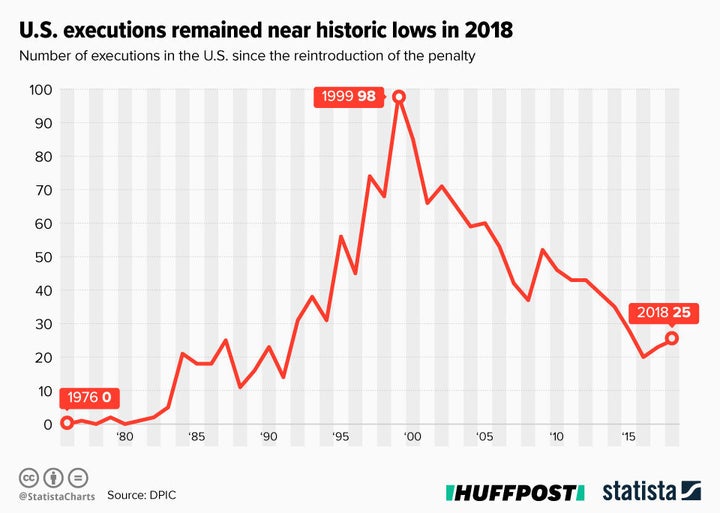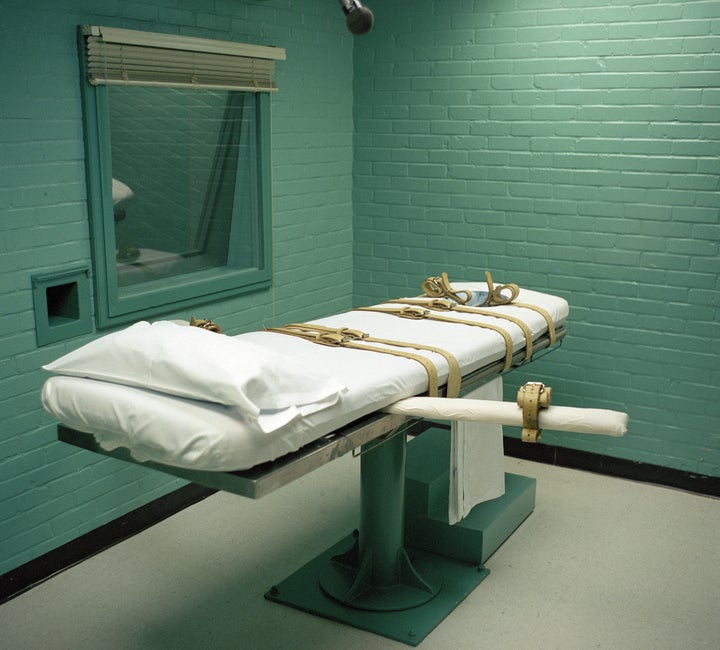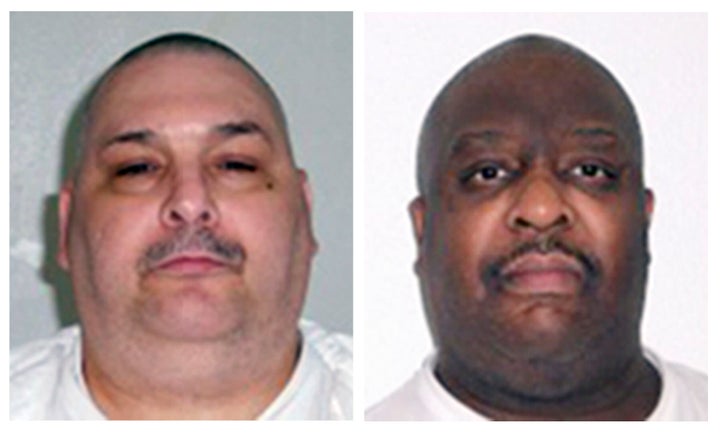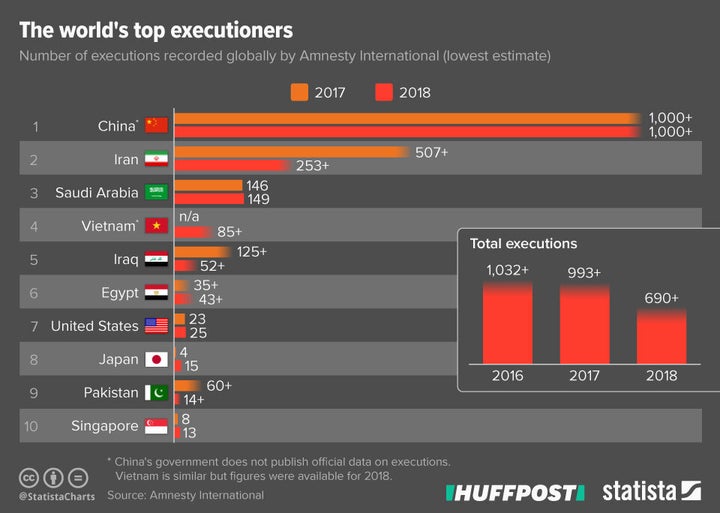The US Justice Department has said it will resume the execution of federal death row inmates and immediately scheduled five, the first time the since 2003.
Donald Trump has made numerous calls for the increase in the use of capital punishment, particularly for drug traffickers, mass shooters and terrorists.
The issue of capital punishment is yet another highly divisive topic in US politics. Attorney General William Barr said in a statement on Thursday that “we owe it to the victims and their families to carry forward the sentence imposed by our justice system”.
But there is strong opposition, especially among Democrats. Senator Dianne Feinstein, said: “The federal government should be leading the effort to end this brutal and often cruel punishment, not advocating for its return.
“It’s time we evolve and put this terrible practice behind us.”
Hang on, hasn’t the US executed people since 2003?
Yes, but these have been state executions rather than federal executions.

The US has two parallel sets of law, one at the state level and another at the federal, nationwide level.
Take the crime of murder – in most cases federal law defers to the state level and the accused will be tried in a state court and, if found guilty, will serve time in a state prison.
If they receive the death sentence, it will be carried out by the state.
But if the victim was an employee of a federal agency such as the FBI for example, the federal courts have the option of prosecuting and the perpetrator would be tried in a federal court and, if sentenced, executed by the Justice Department which runs the federal system.

Whose decision is it to resume federal executions?
It’s ultimately President Trump’s decision and it’s up to the Justice Department to implement it.
Trump has called for increasing the use of the death penalty for drug traffickers and mass shooters, a request the department has since laid the groundwork to carry out.
Early in the Trump administration, former Attorney General Jeff Sessions ordered the Federal Bureau of Prisons to examine what steps might be required to resume the use of the death penalty.
In March 2018, Sessions also called on federal prosecutors to seek the death penalty when bringing cases against drug dealers and traffickers as part of a strategy to help combat the opioid crisis.
Why were they stopped in the first place?
As odd as it sounds, executions are subject to the US Constitution’s Eighth Amendment ban on cruel and unusual punishment, meaning they mustn’t cause unnecessary pain or suffering.
Previously, a “cocktail” of three drugs was used to kill a prisoner – often midazolam to render the prisoner unconscious, vecuronium bromide to halt breathing, and potassium chloride to stop the heart.
But the manufacturers of some of these drugs claimed they were being bought for and used in executions without their knowledge, while the effectiveness of others has also been questioned.
The last federal execution took place in 2003 but since, protracted litigation over the drugs historically used in lethal injection executions prevented the government from continuing the practice, according to Justice Department officials.
Have people suffered during executions?
This is a hotly debated topic – in 2017 Arkansas set out to execute eight inmates in 11 days before its supply of midazolam ran out.
Convicted killer Marcel Williams, 46, was pronounced dead around 10pm local time, just over three hours after fellow killer, 52-year-old Jack Jones, was put to death on the same gurney.
Lawyers for Williams claimed officials had spent 45 minutes trying to place an IV line in Jones’s neck before placing it elsewhere.
They argued, according to local media reports, that Jones was still conscious, moving his lips and “gulping for air” after being administered with midazolam that is supposed to render inmates unconscious.

What about other methods of execution?
Methods such as the electric chair and hanging constitute cruel and unusual punishment in most states but in 2015 Utah voted to resume firing squad executions if lethal injection drugs could not be obtained.
None were carried out.
What does the US public think about capital punishment?
US public support for the death penalty has declined since the 1990s, according to opinion polls, and all European Union nations have abolished it.
UN Secretary-General Antonio Guterres believes the practice should not happen anywhere, spokesman Farhan Haq said on Thursday.
“All the countries that continue to impose the death penalty on the population are flying in the face of what the UN believes is the principled position to end this sort of penalty once and for all,” Haq told reporters.

Who are the five people who will be executed?
The federal inmates include Daniel Lewis Lee, a white supremacist who was convicted in Arkansas for murdering a family of three, including an 8-year-old girl, Reuters reports.
Another is Lezmond Mitchell, a Native American who was found guilty by a jury in Arizona of stabbing a 63-year-old grandmother and forcing her young granddaughter to sit next to her lifeless body on a car journey before slitting the girl’s throat.
The other three inmates who will be executed are Wesley Ira Purkey, who raped and murdered a teenaged girl; Alfred Bourgeois, who sexually molested and killed his young daughter; and Dustin Lee Honken, who shot and killed five people.
Lee will be the first one to be executed, with the date set for 9 December, 2019.
Morris Moon, an attorney for Lee, said in a statement that the trial judge, lead prosecutor and family members of the victims all oppose executing his client, and that unreliable and faulty evidence including hair later proven not to have come from Lee were used against him.
“Given the problems that undermine the fairness and reliability of Danny Lee’s conviction and death sentence, the Government should not move forward with his execution,” Moon said.
The Justice Department said all five executions will take place at the US Penitentiary in Terre Haute, Indiana.

Who else is on federal death row?
There are currently 62 federal inmates on death row, including Dzhokhar Tsarnaev, who planted a deadly bomb at the Boston Marathon in 2013.
Of those 62, 41.9 percent are black, 43.6 percent are white, 11.3 percent are Latino, and Asians and Native Americans each make up 1.6 percent of the federal death row population, according to the Death Penalty Information Center.
Nearly half of all federal death sentences are from Texas, Virginia and Missouri.
“We see really deep geographical and racial bias in the death penalty,” said Cassandra Stubbs, director of the Capital Punishment Project at the American Civil Liberties Union, who added that the Justice Department’s move to bring back executions is out of step with the views of most Americans.
